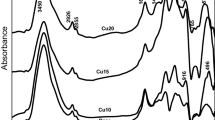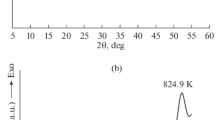Abstract
A detailed analysis of dielectric response and electrical properties of lithium phosphate glasses (LiPO3) as a function of temperature from 20 °C (room temperature) to 170 °C and frequency from 4 Hz to 4 MHz was done using impedance spectroscopy technique. X-ray diffraction (XRD) and differential scanning calorimetry were used to study the structure phase and thermal analysis of the material under investigation, respectively. XRD pattern confirms the amorphous nature of the material. The total conductivity shows two distinct regions, dc conductivity and ac conductivity (σtot(ω) = σdc + A ωr). The ac conductivity’s exponent factor r was found invariant at low-temperature zone and temperature dependent at high-temperature zone. The frequency exponent factor values and its temperature dependence suggested that the jump relaxation model is the best model that can describe the conduction mechanism. Various parameters such as bulk conductivity, dc conductivity, dielectric relaxation time, transition time and the associated activation energies were calculated and discussed. The activation energy of bulk conductivity, dc conductivity and the dielectric relaxation was found to have similar value (0.29 eV). Thermodynamic parameters, such as free energy of activation (ΔF), enthalpy of activation (ΔH) and entropy of activation (ΔS), have been calculated and discussed as well.














Similar content being viewed by others
References
R. Vergaz, D. Barrios, J.M. Sánchez-Pena, C. Pozo-Gonzalo, M. Salsamendi, J.A. Pomposo, Impedance analysis and equivalent circuit of an all-plastic viologen based electrochromic device. Displays 29, 401–407 (2008). https://doi.org/10.1016/j.displa.2007.12.005
H.L. Tuller, M.W. Barsoum, Glass solid electrolytes: past, present and near future—the year 2004. J. Non Cryst. Solids 73, 331–350 (1985). https://doi.org/10.1016/0022-3093(85)90358-8
L. Bih, H. Bih, M. Amalhay, H. Mossadik, A. Elbouari, B. Belhorma, M.P.F. Graça, M.A. Valente, Phosphate glass-glasses as new energy density dielectric materials. Procedia Eng. 83, 371–377 (2014).https://doi.org/10.1016/j.proeng.2014.09.030
I. Jlassi, N. Sdiri, H. Elhouichet, M. Ferid, Raman and impedance spectroscopy methods of P2O5–Li2O–Al2O3 glass system doped with MgO. J. Alloys Compd. 645, 125–130 (2015). https://doi.org/10.1016/j.jallcom.2015.05.025
E.A. Abou Neel, V. Salih, J.C. Knowles, 1.18 Phosphate-based glasses. Compr. Biomater. II, 1(1), 392–405 (2017). https://doi.org/10.1016/b978-0-08-100691-7.00253-6
A.R. Boccaccini, J.E. Gough, Tissue engineering using ceramics and polymers (Woodhead Publishing Limited, 2007). https://doi.org/10.1533/9781845693817
E.A. Abou Neel, J.C. Knowles, Physical and biocompatibility studies of novel titanium dioxide doped phosphate-based glasses for bone tissue engineering applications. J. Mater. Sci. Mater. Med. 19, 377–386 (2008). https://doi.org/10.1007/s10856-007-3079-5
P. Knauth, Inorganic solid Li ion conductors: An overview. Solid State Ionics 180, 911–916 (2009). https://doi.org/10.1016/j.ssi.2009.03.022
B.L. Ellis, W.R.M. Makahnouk, Y. Makimura, K. Toghill, L.F. Nazar, A multifunctional 3.5V iron-based phosphate cathode for rechargeable batteries. Nat. Mater. 6,749–753 (2007). https://doi.org/10.1038/nmat2007
M.H. Braga, J.A. Ferreira, V. Stockhausen, J.E. Oliveira, A. El-Azab, Novel Li3ClO based glasses with superionic properties for lithium batteries. J. Mater. Chem. A. 2, 5470–5480 (2014). https://doi.org/10.1039/c3ta15087a
A. Hayashi, R. Komiya, M. Tatsumisago, T. Minami, Characterization of Li2S-SiS2-Li3MO3 (M=B, Al, Ga and In) oxysulfide glasses and their application to solid state lithium secondary batteries, in: Solid State Ionics, 2002: pp. 285–290. https://doi.org/10.1016/S0167-2738(02)00313-2.
E. Kartini, T.Y.S. Panca Putra, I. Kuntoro, T. Sakuma, K. Basar, O. Kamishima, J. Kawamura, Recent studies on lithium solid electrolytes (LiI)x (LiPO 3 )1- x for secondary battery. J. Phys. Soc. Jpn. 79, 54–58 (2010). https://doi.org/10.1143/JPSJS.79SA.54
L. Bih, Electronic and ionic conductivity of glasses inside the Li2O–MoO3–P2O5 system. Solid State Ionics 132, 71–85 (2000). https://doi.org/10.1016/S0167-2738(00)00697-4
Y.K. Startsev, A.A. Pronkin, I.A. Sokolov, I.V. Murin, Nature of current carriers and electric properties of glasses in xAg2O · (0.2 − x)Tl2O · 0.8B2O3 system. Glass Phys. Chem. 39, 32–44 (2013). https://doi.org/10.1134/S1087659613010124
K. Senevirathne, C.S. Day, M.D. Gross, A. Lachgar, N.A.W. Holzwarth, Y.K. Startsev, A.A.A. Pronkin, I.A.A. Sokolov, I.V.V. Murin, H.-D. Wiemhöfer, A.A.A. Pronkin, Electric conductivity and the nature of electric current carriers in the PbF2-2PbO · SiO2 glasses. Glass Phys. Chem. 39, 32–44 (2013). https://doi.org/10.1134/S1087659613010124
K. Senevirathne, C.S. Day, M.D. Gross, A. Lachgar, N.A.W. Holzwarth, A new crystalline LiPON electrolyte: Synthesis, properties, and electronic structure. Solid State Ionics 233, 95–101 (2013). https://doi.org/10.1016/j.ssi.2012.12.013
R.K. Brow, Review: the structure of simple phosphate glasses. J. Non Cryst. Solids 263–264, 1–28 (2000). https://doi.org/10.1016/S0022-3093(99)00620-1
U. Hoppe, A structural model for phosphate glasses. J. Non Cryst. Solids 195, 138–147 (1996). https://doi.org/10.1016/0022-3093(95)00524-2
P.K. Gupta, Non-crystalline solids: Glasses and amorphous solids. J. Non Cryst. Solids 195, 158–164 (1996). https://doi.org/10.1016/0022-3093(95)00502-1
P. Hockicko, J. Kudelcik, F. Munoz, L. Munoz-Senovilla, Electrical properties of LiPO3 glasses. In: 10th Int. Conf. ELEKTRO 2014—Proc (2014), pp. 654–657. https://doi.org/10.1109/ELEKTRO.2014.6848981
P. Dabas, V. Subramanian, K. Hariharan, Effect of quenching rate on the structure, ion transport, and crystallization kinetics in lithium-rich phosphate glass. J. Mater. Sci. 49(1), 134–141 (2014). https://doi.org/10.1007/s10853-013-7686-x
D. Crespo, P. Bruna, A. Valles, E. Pineda, Phonon dispersion relation of metallic glasses. Phys. Rev. B. 94, 144205 (2016). https://doi.org/10.1103/PhysRevB.94.144205
A.K. Jonscher, Dielectric relaxation in solids. J. Phys. D. Appl. Phys. 32 (1999). https://doi.org/10.1088/0022-3727/32/14/201
R.J. Barczyński, P. Król, L. Murawski, Ac and dc conductivities in V2O5-P2O 5 glasses containing alkaline ions. J. Non Cryst. Solids 356, 37–40 (2010). https://doi.org/10.1016/j.jnoncrysol.2010.07.001
S. Mahboob, G. Prasad, G.S. Kumar, Impedance and a.c. conductivity studies on Ba(Nd0.2Ti 0.6Nb0.2)O3 ceramic prepared through conventional and microwave sintering route. Bull. Mater. Sci. 29, 347–355 (2006). https://doi.org/10.1007/BF02704134
A.A.A. Youssef, The permittivity and ac conductivity of the layered Perovskite [(CH3)(C6H5)3P]2Hgl4, Zeitschrift Fur Naturforsch. Sect. A J. Phys. Sci. 57, 263–269 (2002). https://doi.org/10.1515/zna-2002-0510
M. Cutroni, A. Mandanici, P. Mustarelli, C. Tomasi, M. Federico, Ionic conduction and dynamical regimes in silver phosphate glasses. J. Non Cryst. Solids 307–310 (2002). https://doi.org/10.1016/S0022-3093(02)01561-2
D.P. Singh, K. Shahi, K.K. Kar, Superlinear frequency dependence of AC conductivity and its scaling behavior in xAgI-(1–x) AgPO3 glass superionic conductors. Solid State Ionics 287, 89–96 (2016). https://doi.org/10.1016/j.ssi.2016.01.048
A.A. Saif, P. Poopalan, Correlation between the chemical composition and the conduction mechanism of barium strontium titanate thin films. J. Alloys Compd. 509, 7210–7215 (2011). https://doi.org/10.1016/j.jallcom.2011.04.068
K. Funke, Jump relaxation in solid electrolytes. Prog. Solid State Chem. 22, 111–195 (1993). https://doi.org/10.1016/0079-6786(93)90002-9
K.L. Ngai, H. Jain, O. Kanert, Physical origins of the ω1.0-dependent and the ωq-dependent (q ≈ 1.3) contributions to the conductivity relaxation of glassy ionic conductors. J. Non Cryst. Solids. 222, 383–390 (2004). https://doi.org/10.1016/s0022-3093(97)90140-x
S.R. Elliott, A.c. conduction in amorphous chalcogenide and pnictide semiconductors. Adv. Phys. 36, 135–217 (1987). https://doi.org/10.1080/00018738700101971
A.R. Long, Frequency-dependent loss in amorphous semiconductors. Adv. Phys. 31, 553–637 (1982). https://doi.org/10.1080/00018738200101418
K. Funke, Jump relaxation model and coupling model - a comparison. J. Non Cryst. Solids. 172–174, 1215–1221 (1994). https://doi.org/10.1016/0022-3093(94)90646-7
R. Vaish, K.B.R. Varma, Dielectric properties of Li2O–3B2O3 glasses. J. Appl. Phys. 106, 064106 (2009). https://doi.org/10.1063/1.3225583
D.P. Almond, G.K. Duncan, A.R. West, The determination of hopping rates and carrier concentrations in ionic conductors by a new analysis of ac conductivity. Solid State Ionics 8, 159–164 (1983). https://doi.org/10.1016/0167-2738(83)90079-6
A.A. Ali, M.H. Shaaban, Electrical properties of LiBBaTe glass doped with Nd2O3. Solid State Sci. 12, 2148–2154 (2010). https://doi.org/10.1016/j.solidstatesciences.2010.09.016
F. Munoz, A. Duran, L. Pascual, L. Montagne, B. Revel, A. Rodrigues, Increased electrical conductivity of LiPON glasses produced by ammonolysis. Solid State Ionics 179, 574–579 (2008). https://doi.org/10.1016/j.ssi.2008.04.004
S. Havriliak, S. Negami, A complex plane representation of dielectric and mechanical relaxation processes in some polymers. Polymer (Guildf). 8, 161–210 (1967). https://doi.org/10.1016/0032-3861(67)90021-3
K.S. Cole, R.H. Cole, Dispersion and absorption in dielectrics I. Alternating current characteristics. J. Chem. Phys. 9, 341 (1941). https://doi.org/10.1063/1.1750906
J.G. Powles, Dielectric relaxation and the internal field. J. Chem. Phys. 21, 633 (1953). https://doi.org/10.1063/1.1698980
M.F. Kotkata, F.A. Abdel-Wahab, H.M. Maksoud, Investigations of the conduction mechanism and relaxation properties of semiconductor Sm doped a-Se films. J. Phys. D. Appl. Phys. 39(10)(2006). https://doi.org/10.1088/0022-3727/39/10/013
N.J. Tharayil, S. Sagar, R. Raveendran, A.V. Vaidyan, Dielectric studies of nanocrystalline nickel–cobalt oxide. Phys. B Condens. Matter 399, 1–8 (2007). https://doi.org/10.1016/j.physb.2007.03.037
F.E. Salman, N. Shash, H. Abou El-Haded, M.K. El-Mansy, Electrical conduction and dielectric properties of vanadium phosphate glasses doped with lithium. J. Phys. Chem. Solids. 63(11) (2002). https://doi.org/10.1016/S0022-3697(02)00164-6
P.B. Macedo, C.T. Moynihan, R. Bose, Role of ionic diffusion in polarization in vitreous ionic conductors. Phys. Chem. Glass 13, 171–179 (1972). https://doi.org/10.4236/ns.2014.66038
P. Debye, Polar molecules (Chemical Catalog Co., Inc., New York, 1929), pp. 172. https://doi.org/10.1002/jctb.5000484320[J. Soc. Chem. Ind. 48 (2007) 1036–1037]
S. Glasstone, K.J. Laidler, H. Eyring, The Theory of Rate Processes: The Kinetics of I Chemical Reactions, Viscosity, Diffusion and Electrochemical Phenomena, 1st edn. (McGraw-Hill, New York, 1941), pp. 13–15. https://doi.org/10.1038/149509a0 (introduction)
H. Eyring, Viscosity, plasticity, and diffusion as examples of absolute reaction rates. J. Chem. Phys. 4, 283–291 (1936). https://doi.org/10.1063/1.1749836
H. A. Hashem, S. Abouelhassan, Physics, dielectric and thermodynamic properties of tin (II) sulfide thin films. Chin. J. Phys. 43, 955–966 (2005)
K.K. Srivastava, A. Kumar, O.S. Panwar, K.N. Lakshminarayan, Dielectric relaxation study of chalcogenide glasses. J. Non Cryst. Solids 33, 205–224 (1979). https://doi.org/10.1016/0022-3093(79)90050-4
Author information
Authors and Affiliations
Corresponding author
Additional information
Publisher's Note
Springer Nature remains neutral with regard to jurisdictional claims in published maps and institutional affiliations.
Rights and permissions
About this article
Cite this article
Hamam, K.J., Salman, F. Dielectric constant and electrical study of solid-state electrolyte lithium phosphate glasses. Appl. Phys. A 125, 621 (2019). https://doi.org/10.1007/s00339-019-2868-2
Received:
Accepted:
Published:
DOI: https://doi.org/10.1007/s00339-019-2868-2




